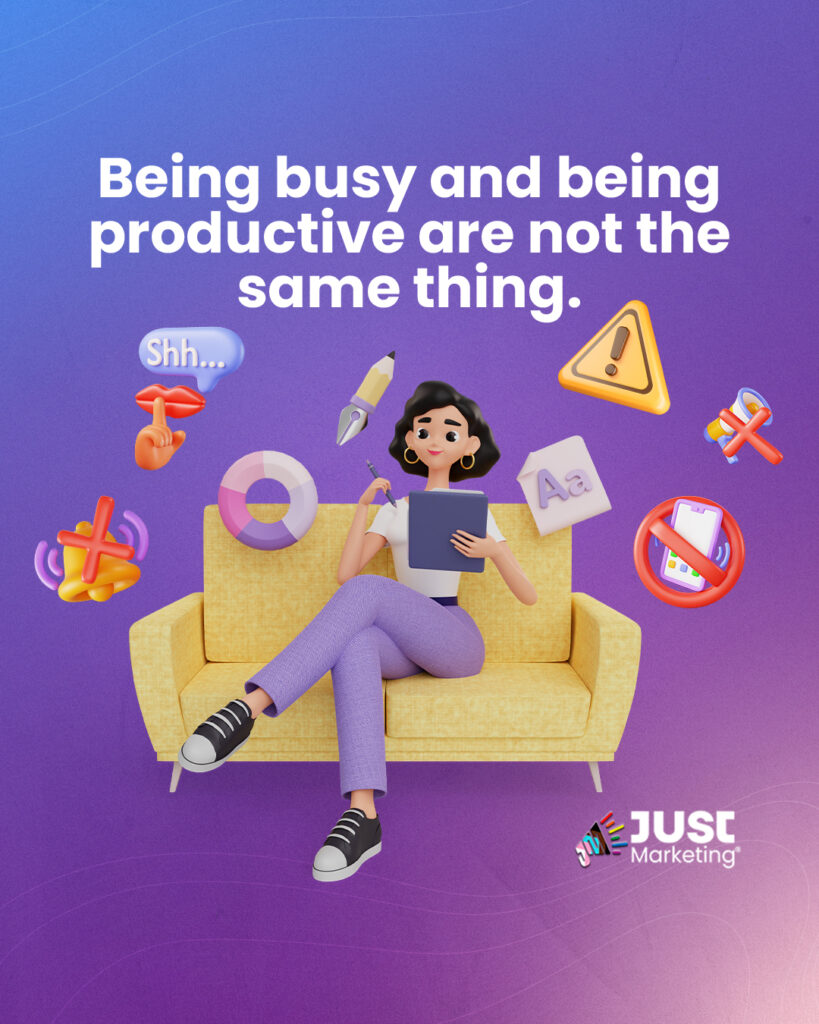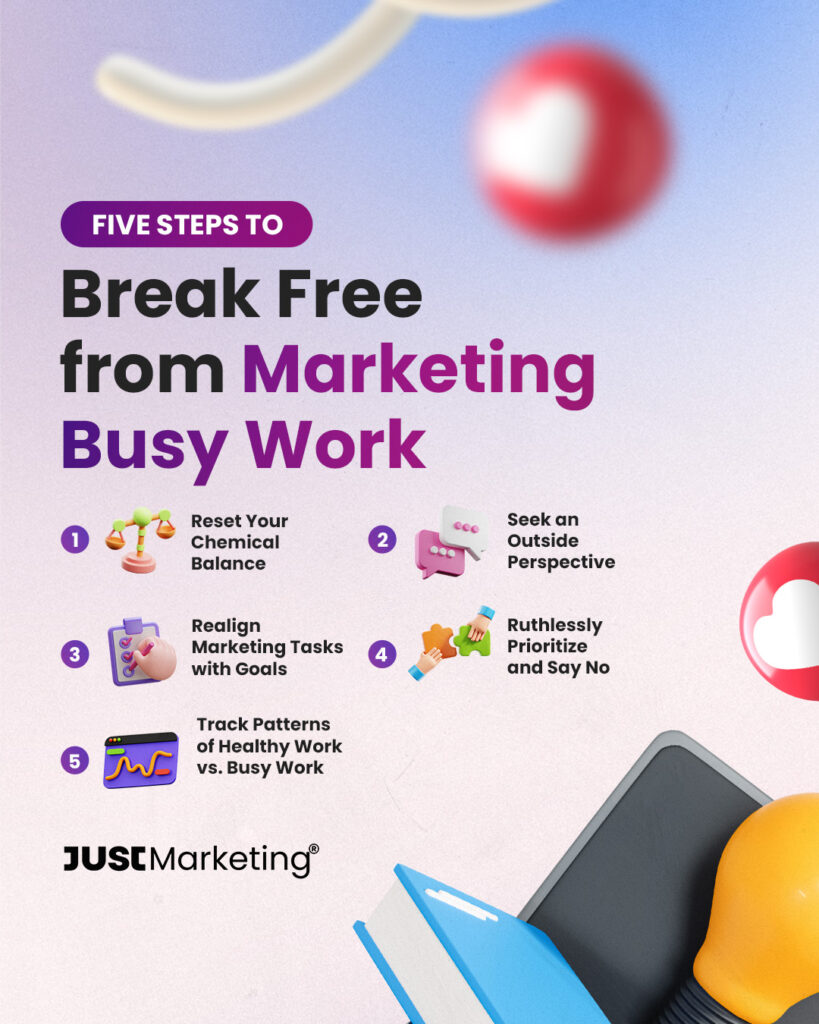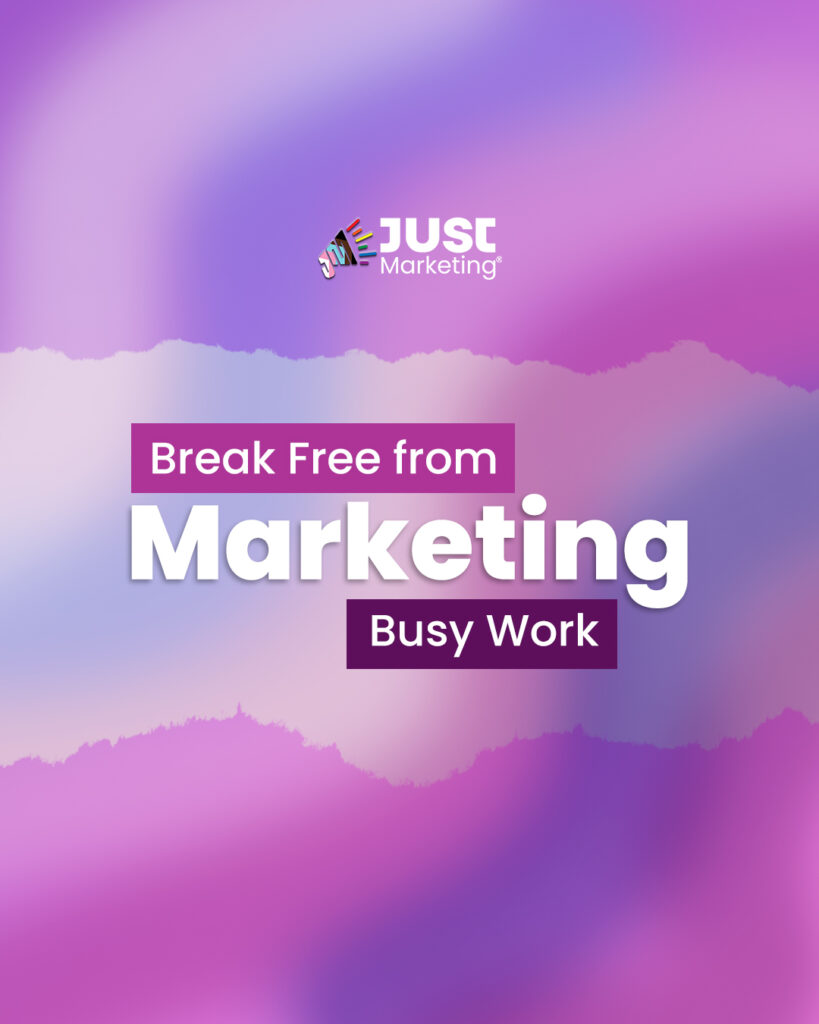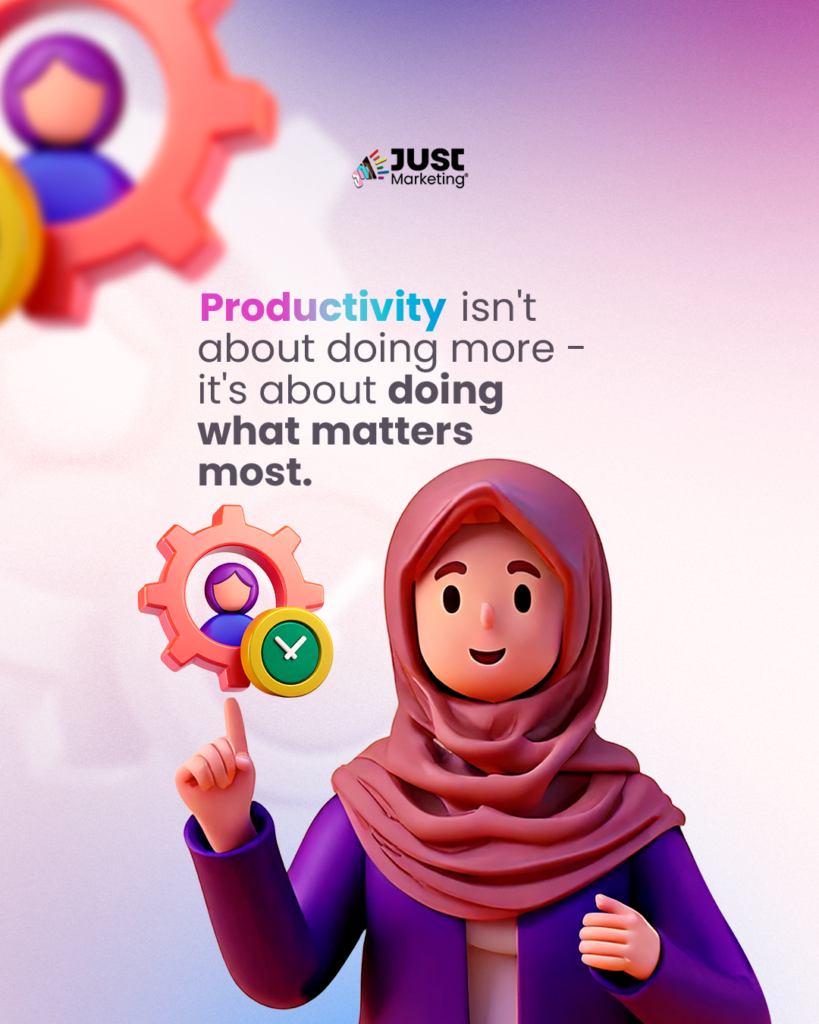Have you ever wrapped up a long day of marketing tasks – posting on social media, tweaking website copy, answering emails – only to feel like you’ve barely moved the needle? It’s frustrating, isn’t it? You’re busy, your to-do list is shrinking, but the progress you crave feels out of reach.
If you’re nodding along, you’re not alone. For many entrepreneurs, especially those navigating life with ADHD, it’s easy to mistake busyness for productivity. But here’s the truth: marketing busy work isn’t just a time suck. It drains your energy, stifles your creativity, and, yes, even eats away at your bottom line.
The good news? You can break free from the cycle of busy work and focus on marketing efforts that truly make an impact. In this post, I’m sharing five ADHD-friendly strategies to help you cut through the noise, prioritize what matters, and create meaningful progress toward your goals.
Because real success in marketing – and in business – isn’t about doing more. It’s about doing what matters most.
The Hidden Costs of Marketing Busy Work
Let’s get one thing straight: being busy and being productive are not the same thing. In marketing, it’s all too easy to fill your days with tasks that feel productive – like fine-tuning a logo, obsessing over hashtags, or responding to every comment – but don’t actually drive your business forward. These are classic examples of marketing busy work.

When you’re caught in this cycle, it can feel like you’re accomplishing a lot. But take a step back and ask yourself: Are these activities directly contributing to my goals? Are they increasing brand awareness, driving website traffic, or boosting sales? If the answer is no, you’re spinning your wheels.
The cost of this cycle is higher than you might think. Here’s why:
- Time Drain: Every hour spent on low-impact tasks is an hour stolen from activities that actually grow your business.
- Energy Burnout: Constantly switching between tasks or chasing perfection exhausts your mental and emotional energy, leaving less bandwidth for creative, strategic work.
- Missed Opportunities: By focusing on busy work, you may overlook high-impact marketing opportunities like building partnerships, engaging meaningfully with your audience, or launching innovative campaigns.
- Financial Loss: Every misaligned marketing task is a hidden cost – whether it’s the hours you could have billed to clients or the leads you didn’t convert because your focus was elsewhere.
For entrepreneurs with ADHD, the problem can be even more pronounced. Dopamine-driven tasks, like responding to notifications or checking metrics obsessively, provide instant gratification but rarely produce long-term results.
But here’s the thing: breaking free from busy work isn’t just possible – it’s essential. And it starts with shifting your focus to what truly matters. Ready to learn how? Let’s explore the steps to break the cycle and reclaim your time, energy, and impact.
Five Steps to Break Free from Marketing Busy Work
Escaping the busy work trap isn’t about adding more to your plate – it’s about working smarter, not harder. The key lies in shifting your focus and energy toward activities that drive meaningful results. In this section, we’ll explore five practical steps to help you realign your efforts, starting with a crucial reset for your brain and body.

Step 1: Reset Your Chemical Balance
When you’re trapped in the busy work cycle, it’s not just your to-do list that’s out of balance – your brain chemistry plays a role too. For those with ADHD, dopamine and norepinephrine are the unsung heroes of focus and motivation. When these levels are out of sync, it’s easy to get stuck in a loop of low-impact tasks, chasing quick hits of satisfaction without making meaningful progress.
To break free, you need to reset your brain’s natural rhythm. This isn’t about overhauling your entire routine; it’s about small, intentional actions that create a sense of calm and clarity.
Tips for Resetting
- Take Micro-Breaks: Step away from your workspace for a few minutes to stretch, hydrate, or simply change your environment. A five-minute reset can refresh your focus and help you reassess priorities.
- Incorporate Physical Activity: Movement, even something as simple as a quick walk, can boost dopamine and help regulate your mood.
- Practice Mindfulness: Engage in deep breathing or meditation exercises to bring your nervous system back to baseline. Apps like Insight Timer or Calm can guide you through ADHD-friendly techniques.
By grounding yourself with these simple resets, you’ll create the mental clarity needed to move beyond busy work and start tackling tasks that truly matter.
Step 2: Seek an Outside Perspective
When you’re deep in the weeds of busy work, it’s easy to lose sight of the bigger picture. Tasks that feel urgent may not actually align with your goals, but in the moment, they can be hard to recognize. That’s why seeking an outside perspective is so powerful – it brings fresh eyes and clarity to what truly matters.
An external viewpoint can act as a reality check. A trusted coach, colleague, or mentor can help you evaluate your workload and identify which tasks are high-impact versus which ones are keeping you busy but not productive. Often, they’ll spot patterns or solutions that you might miss when you’re too close to the problem.
Tips for Getting Perspective
- Find Your Sounding Board: Share your goals and current projects with someone who understands your business and values. This might be a business coach, an accountability partner, or even a friend with a knack for strategic thinking.
- Ask the Right Questions: When seeking input, be specific. For example:
- “Which of these tasks do you think will have the biggest impact?”
- “Am I focusing on the right priorities, or am I overcomplicating things?”
- Welcome Feedback Without Defensiveness: Keep an open mind. Remember, this isn’t criticism – it’s a tool to help you get unstuck and make progress.
- Schedule Regular Check-Ins: Build a habit of seeking outside perspective by setting up weekly or monthly review sessions with your sounding board.
By allowing someone else to help you sift through your to-dos, you’ll not only gain clarity but also ensure your time and energy are directed toward what matters most.

Step 3: Realign Marketing Tasks with Goals
Once you’ve reset your focus and gathered outside perspective, it’s time to take a hard look at your current projects. Are they truly aligned with your long-term marketing goals? Or are they distractions dressed up as “must-dos”?
This step requires you to evaluate your efforts and let go of tasks that don’t directly contribute to meaningful progress.
Busy work often masquerades as productivity, but without alignment to your goals, it’s just noise. For example:
- Posting daily on social media without a strategy might feel productive, but if it’s not driving engagement or traffic, it’s wasted effort.
- Spending hours perfecting a blog post layout may look like dedication, but if it delays publishing high-quality content, it’s holding you back.
Focusing on aligned tasks ensures that your time and energy are spent on actions that move the needle, whether that’s building brand awareness, increasing website traffic, or driving sales.
Tips for Realignment
- Revisit Your Goals: Start by clarifying your top 2–3 marketing objectives. For instance, are you focused on growing your email list, increasing client inquiries, or boosting social media engagement?
- Audit Your Current Tasks: List everything you’ve been working on and ask:
- Does this directly support my goals?
- If not, why am I doing it?
- Trim the Fat: Eliminate or delegate tasks that aren’t essential. Freeing up this space allows you to redirect your efforts toward higher-impact work.
- Focus on the Big Wins: Identify high-value activities that have a measurable impact, like creating lead magnets, optimizing your website for conversions, or building an engaged email audience.
By consistently aligning your marketing tasks with your bigger vision, you’ll stop spinning your wheels and start making real progress.
Step 4: Ruthlessly Prioritize and Say No
Breaking free from busy work means becoming laser-focused on what truly matters – and that requires learning to say no. Whether it’s declining external requests or resisting your own impulse to chase shiny new ideas, prioritization is the skill that will keep you on track.
Every time you say yes to a task that doesn’t align with your goals, you’re saying no to something more important. This can lead to:
- Overcommitment, which drains your energy.
- Lost opportunities to focus on high-impact activities.
- A cycle of busyness that leaves little room for meaningful progress.
By setting boundaries and prioritizing ruthlessly, you’ll protect your time and energy for the tasks that matter most.
Tips for Prioritizing
- Define Your Top Priorities: Identify the 2–3 tasks that will have the biggest impact on your goals this week. Keep them front and center in your planning.
- Evaluate Opportunities: When new opportunities arise, ask yourself:
- Does this align with my goals?
- Will it move me closer to my long-term vision?
- Do I have the bandwidth to do this well without sacrificing other priorities?
- Practice Saying No:
- To others: Politely decline tasks or projects that don’t serve your goals. Use phrases like, “I’d love to help, but I’m focusing on X right now.”
- To yourself: Resist the urge to take on nonessential tasks, even if they seem exciting or productive in the moment.
- Use a Prioritization Framework: Tools like the Eisenhower Matrix can help you categorize tasks by urgency and importance, making it easier to say no to low-priority items.
Saying no isn’t about being rigid or unhelpful – it’s about being strategic. Protecting your time and energy allows you to focus on the activities that truly drive progress, ensuring you’re working smarter, not harder.
Step 5: Track Patterns of Healthy Work vs. Busy Work
The final step to breaking free from the busy work trap is building self-awareness. By tracking your work habits and identifying patterns, you’ll gain a clearer understanding of what meaningful, focused work feels like – and how to recognize when you’re slipping back into busy work.
Without reflection, it’s easy to repeat the same unproductive behaviors. Tracking your work not only helps you see what’s working but also provides insight into when and why you veer off course. This self-awareness is a powerful tool for staying aligned with your goals over the long term.
Tips for Tracking Patterns
- Keep a Daily Journal: Spend a few minutes at the end of each day reflecting on your work. Write down:
- What tasks felt meaningful and moved you closer to your goals.
- What tasks felt like busy work or distractions.
- Look for Triggers: Identify what circumstances lead you into busy work. Is it a lack of clarity? Overwhelm? A specific time of day? Recognizing these patterns can help you create strategies to avoid them.
- Note Energy Levels: Pay attention to when you feel most focused and productive versus when you’re prone to procrastination or distraction. Use this insight to schedule high-priority tasks during your peak energy times.
- Celebrate Wins: Reflect on the progress you’ve made toward your goals. Positive reinforcement helps build habits that keep you on track.
By tracking your patterns, you’ll develop the ability to quickly distinguish between healthy, goal-oriented work and tasks that just keep you busy. Over time, this practice becomes second nature, empowering you to stay focused on meaningful marketing efforts and avoid the busy work trap for good.
Breaking the Marketing Busy Work Cycle for Good
Productivity isn’t about doing more – it’s about doing what matters most. Breaking free from the busy work cycle isn’t a one-time fix; it’s a shift in how you approach your marketing and your business. The good news? It’s entirely possible with small, consistent changes that align your actions with your goals.

Let’s revisit the five steps that will help you escape the trap of busy work and focus on meaningful progress:
- Reset Your Chemical Balance: Take small, intentional breaks to clear your mind and restore focus.
- Seek an Outside Perspective: Invite trusted feedback to identify high-impact priorities.
- Realign Your Marketing Tasks with Goals: Audit your activities and let go of what doesn’t serve your vision.
- Ruthlessly Prioritize and Say No: Protect your time by focusing on what truly matters and declining distractions.
- Track Patterns of Healthy Work vs. Busy Work: Reflect daily to understand what works, avoid pitfalls, and build better habits.
Each of these steps is designed to help you reclaim your energy and focus while ensuring your marketing efforts deliver real results.
Remember, breaking free from busy work doesn’t happen overnight. It’s a process of learning, adjusting, and realigning – but every small step you take will bring you closer to the marketing success you’re working so hard to achieve.
You’re not alone in this journey. Many entrepreneurs – especially those with ADHD – face the same struggles, and the fact that you’re here, taking action, speaks volumes about your commitment to making meaningful progress.
Start small. Focus on one step today, and let the momentum build. Over time, you’ll create a sustainable system that frees you from the trap of busy work and empowers you to reach your goals with clarity and confidence.
If you’re ready to break free from marketing busy work and focus on strategies that drive real results, sign up for my newsletter or follow me on Facebook, Instagram, LinkedIn, or BlueSky!
I look forward to connecting with you!

